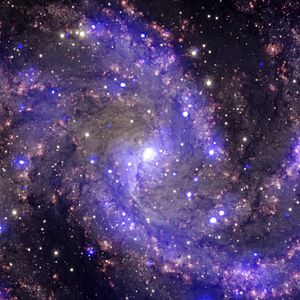This is an old revision of this page, as edited by 2.25.45.251 (talk) at 12:08, 6 August 2017. The present address (URL) is a permanent link to this revision, which may differ significantly from the current revision.
Revision as of 12:08, 6 August 2017 by 2.25.45.251 (talk)(diff) ← Previous revision | Latest revision (diff) | Newer revision → (diff)| NGC 6946 | |
|---|---|
 Spiral galaxy NGC 6946 Spiral galaxy NGC 6946 | |
| Observation data (J2000 epoch) | |
| Constellation | Cepheus & Cygnus |
| Right ascension | 20 34 52.3 |
| Declination | +60° 09′ 14″ |
| Redshift | 0.000160 |
| Heliocentric radial velocity | 48 ± 2 km/s |
| Distance | 22.5 ± 7.8 Mly (6.9 ± 2.4 Mpc) |
| Apparent magnitude (V) | +9.6 |
| Characteristics | |
| Type | SAB(rs)cd |
| Apparent size (V) | 11.5 x 9.8 arcmin |
| Other designations | |
| UGC 11597, PGC 65001, Arp 29, Caldwell 12 | |
NGC 6946 (also known as the Fireworks Galaxy) is an intermediate spiral galaxy about 22 million light-years away, in the constellations of Cepheus and Cygnus. It was discovered by William Herschel on 9 September 1798. NGC 6946 is highly obscured by interstellar matter of the Milky Way galaxy, as it is quite close to the galactic plane. The true diameter of the galaxy is approximately 40,000 light-years or just about one-third of the Milky Way's size. In the past century, ten supernovae have been observed to explode in the arms of this galaxy, which has been classified as a starburst galaxy. Chandra Space Telescope observations have revealed three of the oldest supernovae ever detected in X-rays. This composite image also includes optical data from the Gemini Observatory in red, yellow, and cyan.
Supernovae
Ten supernovae have been observed in NGC 6946 in the last 100 years: SN 1917A, SN 1939C, SN 1948B, SN 1968D, SN 1969P, SN 1980K, SN 2002hh, SN 2004et, SN 2008S, and SN 2017eaw. This makes it the most prolific known galaxy for this type of event over a period of 100 years. By comparison, the Milky Way galaxy, which has double the number of stars as NGC 6946, averages one supernova event per century. It also contains a failed supernova, potential black hole-forming star N6946-BH1.
References
- ^ "NASA/IPAC Extragalactic Database". Results for NGC 6946. Retrieved 2006-11-18.
- "Distance Results for NGC 6946". NASA/IPAC Extragalactic Database. Retrieved 2010-06-18.
- Boen, Brooke (20 May 2015). "NGC 6946: The 'Fireworks Galaxy'". NASA. Retrieved 2016-12-08.
- Nemiroff, R.; Bonnell, J., eds. (1 January 2011). "Fireworks Galaxy NGC 6946". Astronomy Picture of the Day. NASA.
- http://www.astronomerstelegram.org/?read=10372
- http://www.astronomerstelegram.org/?read=10376
- "List of Supernovae". Harvard-Smithsonian Center for Astrophysics (IAU). Retrieved 2010-07-12.
- "Gemini Observatory Welcomes 2005 with Release of Galactic Fireworks Image", Gemini Observatory, 1 January 2005, retrieved 2016-01-04.
- Adams, S. M.; Kochanek, C. S.; Gerke, J. R.; Stanek, K. Z.; Dai, X. (9 September 2016). "The search for failed supernovae with the Large Binocular Telescope: conformation of a disappearing star". arXiv:1609.01283v1.
{{cite journal}}: Cite journal requires|journal=(help)
External links
- SEDS: Spiral Galaxy NGC 6946
- Pictures of NGC 6946
- Atlas of the Universe
- N6946-BH1 Giant Star Becomes A Black Hole Right Before Our Eyes!
- NGC 6946 on WikiSky: DSS2, SDSS, GALEX, IRAS, Hydrogen α, X-Ray, Astrophoto, Sky Map, Articles and images
| Astronomical catalogs | |
|---|---|
| NGC | |
| PGC | |
| UGC | |
| Caldwell | |
| Arp | |